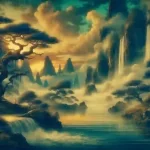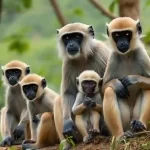Starting on his poetic career during the forties in association with the Jayanti, Navakanta Barua continued to express himself through the Pachowa and the Ramdhenu the two magazines that became the pivots of the modernist movement in Assamese poetry during the late forties and the fifties respectively. Essentially a romantic lyricist, Barua’s early poems carry the influence of Tagore. One notes in them a pervasive mood of nostalgia, a romantic, wistful longing for those values for which poet Barua’s familiar symbols are the far-off, limitless sky and the green earth. The modernist flavor that he brought to Assamese poetry was the result of his treatment of urban subjects and his Eliotic use of symbols and images, blending the serious with the light, applying the language of conversation and prose rhythms, and introducing a wide variety of rhythmic patterns. His modernist attitude to life is also characterised by his non-committal attitude towards all matters of conventionally accepted faith. It is to be noted however, that his kinship to T.S Eliot was only peripheral and external: the ambivalence and complexity, the intellectual depth and subtlety, and the blending of the ironical and the satirical in Eliot’s poetry are missing in Barua’s essentially romantic sensibility. There is no doubt, however, that with the publication of his three collections of poems Hey Aranya Hey Mahanagar, Eti Duti Egharati Tara and Jati aru Keitaman Sketch during the fifties. In more sense than one, he prepared the stage for the emergence of the major poets of the sixties by introducing varied modes of poetic expression in modern Assamese poetry with a remarkable sophistication. That way he serves as the bridge between the earlier period of romantic effusion and the later phase of greater condensation and suggestive richness that we find in the poetry of the sixties.
Another poet of the forties, Hem Barua, brought his social consciousness and political ideas to bear on his poetry. Deliberately anti-romantic in his use of imagery, he very often betrays his romantic dreaminess in a vague desire for social change. With all his weakness, Hem Barua, however, succeeded in setting a trend of writing poems with a certain socio-political consciousness which found many an avid follower among the poets of the fifties. A pioneer in the use of free verse, and prose rhythm Hem Barua’s importance as a poet is largely historical.
It may be noted that Ajit Barua, who combined the hard compactness of the Imagists and the suggestivity of T. S. Eliot’s post-Symbolist mode in his later poems published during the late forties, made his first adolescent debut at writing a poem in the early forties when his poem Haturi was published. It was in his poems that post-War modern Assamese poetry found its first mature from during the late forties. His Man-Kunwali Samay is a well-knit piece, recording a mood of the poet on an autumnal morning-full of mists : it is a moment when the past and the present are suddenly telescoped together as if in a dream. Time itself seems to stand still, as an invisible bridge joins together the poet’s past, childhood memories with his present mood. There is a touch of the Surrealistic in this evocation of a state of the sub-conscious. In its use of ‘fluid’, suggestive and evocative words, and, also, in the application of Synaesthesia, the poem reminds us of the Symbolist technique.
As we read Ajit Barua’s Dukhar Kavita, we are impressed by the surprising compactness of form of the poem. There are marks of T.S. Eliot’s influence in the use of quotations, not only as motto, but also in the body of the poem. The poem was composed as an elegiac piece on the accidental death 0f a brilliant friend who was drowned to death in the Brahmaputra. In the first stanza the poet seeks to depict his impression of how death came to this youngman. The use of the neologism ‘sontal’ is significant. The hard, compressed image in the expression Kathin ghamar Chhaki by which the poet seeks to picture this tragic death of a hard-working, brilliant young man is specially remarkable. In the second stanza, the poet continues deliberating on this watery death. There is also a blending of lighter vein in the second two lines with the serious in the first two lines. In the third stanza, the poet asks others to shed tears over this death – “tears that reason cannot reach”. In the line, opare akash tale pani, there is an attempt to capture the eternal, the unchanging image of life in nature. The last line echoes the well-known Shakespearean lines in “The Tempest” :
“Full fathom five thy father lies ;
Of his bones are coral made ;
Those are pearls that were his eyes”.
The idea of the transformation of the eyes into pearls, when applied to the death of this brilliant young man, possibly carries a suggestion of the poet’s belief in a similar magic transformation of the physical, time-limited into the supernatural and the eternal.
Ajit Barua’s mature mind and fine sensibility could easily absorb the subtle and complex technical innovations of Western modernist poetry and make these his own. He has been able to express his modern sensibilities in terms of purely Assamese idioms in a way in which many followers of Western poetic movement, especially during the fifties, could not. However, the familiar charge of obscurity may be brought against him as well-specially in the case of the piece just discussed, where, unless one knows the back-ground of the poem, one will find it difficult to follow the thread of his ‘meaning’.
The fifties witnessed the poetic activities of a number of poets among who are, besides Navakanta Barua, Hari Barkakati, Homen Borgahain, Mahim Bora, Bireswar Barua, Prafulla Bhuyan, Nilmoni Phookan, Sushil Sarma, Hem Barua, Keshab Mahanta, Amalendu Guha, Mahendra Bora, Ram Gogoi, Hemango Biswas, Dinesh Goswami, Hiren Gohain, and others. As we have already noted, the most remarkable poet of this decade is Navakanta Barua whose best collections of poems came out during this decade. Among the group of poets who carried on with the ‘progressive’ ideal set by Bhabananda Dutta and Amulya Barua during the forties, were Keshab Mahanta, Ram Gogoi, Amalendu Guha and Hemango Biswas. Sometimes their political leanings became too obvious, as in the case of Ram Gogoi ; at other times, poetic painting and singing could rise above their political commitments as we find in Amalendu Guha’s Bagichat Deobar and Keshab Mahanta’s memorable poems, Aghonar Kunwali and Ayojan Shesh.
The other poets of the decade, though evincing a general awareness of the social realities-such awareness being a dominant characteristic of the intellectual climate of the decade-cannot be characterized as subscribing to any particular line of political commitment. One of them is Hari Barkakati, who is still a practising poet, and is essentially a poet of romantic sensibility, reacting, either ruefully or cynically against the harsh realities of urban life. It is by virtue of the conversational tone and use of unconventional imagery that his poems acquire the modern touch.
Mahim Bora, another poet of the fifties, and better known as a distinguished short story writer, has shown a sensitive mind and breadth of imagination in a few pieces he has written. His short pieces like Mach remind one of Georgian poetry.
Emdad Ullah: From Assam has been translating many Assamese poets into English. He is a Lecturer in English, Arya Vidyapith College, Guwahati, an Asstt. Editor for Assam Express. His works include Sirjan Aru Manon, Kabitar Sabishes, Loo Gubbbare (short stories translated from Hindi); The Rhythms of Broken Dreams (poetry, translation from Assamese to English)





Leave a Reply